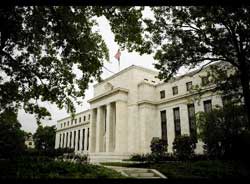By Bill Hall – Money and Markets
U.S. stocks have jumped 16 percent so far in 2013 for the fifth straight year of increases. So why are investors so unhappy?
Because we’re living in an unreal world. Let me explain.
Equity markets have benefited because investors — both institutional and individual — have decided they need more risky assets, primarily stocks, in their portfolios. As a result, Wall Street has coined yet another new phrase to explain the effect of investors moving out of bonds and into shares: the “Great Rotation.”
This switch in allocation reflects, to mint a phrase of my own, “bank-rate fatigue.” Central banks around the world, led by the Federal Reserve in the U.S., have printed trillions of dollars to lower interest rates, driving investors from the skimpy yields of cash.
Three Consequences
Yet there are three main questions raised by this.
First, why are central banks encouraging this type of behavior? Because their objective is to get the world economy moving again by pushing up asset prices. The theory goes that if asset prices rise enough, a “wealth effect” is encouraged: Companies raise capital more easily, and this is recycled back into the economy.
Second, what does this tell you about what central banks think of the economy? They think the economy is likely to remain subdued for a long time.
Some say the current monetary policy is debasing currencies and threatening inflation. This is most likely correct, but nobody knows when and by how much inflation will accelerate — we are firmly in an era of experimental economics. It’s a time in which the immediacy of economic problems demands unorthodox measures. If, by happenstance, current policies trigger some inflation, well, governments are highly indebted and will benefit from it.
Third, how do you value anything when market prices are being distorted? This is tricky. The problem for investors today is that there is no anchor — prices of all major assets are being manipulated. In an absolute sense, markets are expensive, but does that hold true when rates are near zero or when central banks are supplying almost limitless liquidity?
Consider that most investments rarely fall simply because they are expensive. They decline when they are expensive, but there needs to be a trigger, and that is usually the withdrawal of liquidity. That typically takes the form of a rise in interest rates — something that looks unlikely today. As a result, we may stay in a time of heightened risk for a long time, and asset prices could be pushed much higher.
The Way Forward
So what’s an investor to do? Be cautious but know stocks can be supported, however irrationally, by central banks’ flood of liquidity.
Using another recently minted Wall Street phrase, I believe the markets are in a state of “stable disequilibrium,” where hyperactive central bankers will continue to be investors’ best friend. This means that for asset prices to remain lofty, investors must depend on the adventurous actions of central bankers.
That’s why, as an investor, you ideally want to own assets that central banks can’t print. That way you can build enduring and sustainable value in your portfolio.
Your portfolio should revolve around a solid core invested in the shares of high-quality companies that are domiciled around the globe and control their own destiny. Depending on your objectives, you should also consider commodities, precious metals, short-term fixed-income securities and a variety of alternative-investment strategies.
In these uniquely unusual times, it’s now more important than ever to know yourself and your ability to take on risk because there’s plenty of fool’s gold out there. So guard your capital carefully.








